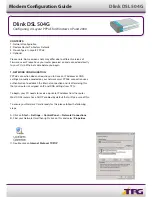
SR808ac Cable Modem User Manual
28
7223(config-router)#no validate-update
7223(config-router)#passive-interface cable 2/0
7223(config-router)#network 10.0.0.0
7223(config-router)#exit
7223(config)#inter cable 2/0
7223(config-if)#ip rip receive ver 2
7223(config-if)#ip rip authentication mode md5
7223(config-if)#ip rip authentication key-chain ubr
7223(config-if)#exit
7223(config)#exit
In this example, we have named the key chain ‘ubr’. This was chosen arbitrarily. You
can use any name you like as long as you specify the correct name when specifying
which key chain to use for RIPv2 authentication.
2.) The next step is enable RIP debugging to ensure that the CMTS is receiving and
authenticating messages from the residential gateway.
7223#debug ip rip
RIP protocol debugging is on
7223#term mon
The CMTS is now configured to accept RIPv2 messages. If the CMRG is registered
on the CMTS, you should see messages that are similar to the message below:
00:28:41: RIP: received packet with MD5 authentication
00:28:41: RIP: received v2 update from 10.24.81.148 on Cable2/0
00:28:41:
10.24.81.0/24 via 10.24.81.148 in 1 hops
The CMRG has broadcast that is connected to the network 10.24.81.0/24 through
the interface 10.24.81.148. This information is not very useful to the CMTS because it
already knows that the network 10.24.81.0/24 is connected directly to one of its
interfaces (Cable2/0). It ignores this message and doesn’t add any information to the
IP routing table. Here is the IP routing table after the CMTS has received RIPv2
messages:
7223#sh ip route
Codes: C - connected, S - static, I - IGRP, R - RIP, M - mobile, B - BGP
D - EIGRP, EX - EIGRP external, O - OSPF, IA - OSPF inter area
N1 - OSPF NSSA external type 1, N2 - OSPF NSSA external type 2
E1 - OSPF external type 1, E2 - OSPF external type 2, E - EGP
i - IS-IS, L1 - IS-IS level-1, L2 - IS-IS level-2, ia - IS-IS inter area
















































